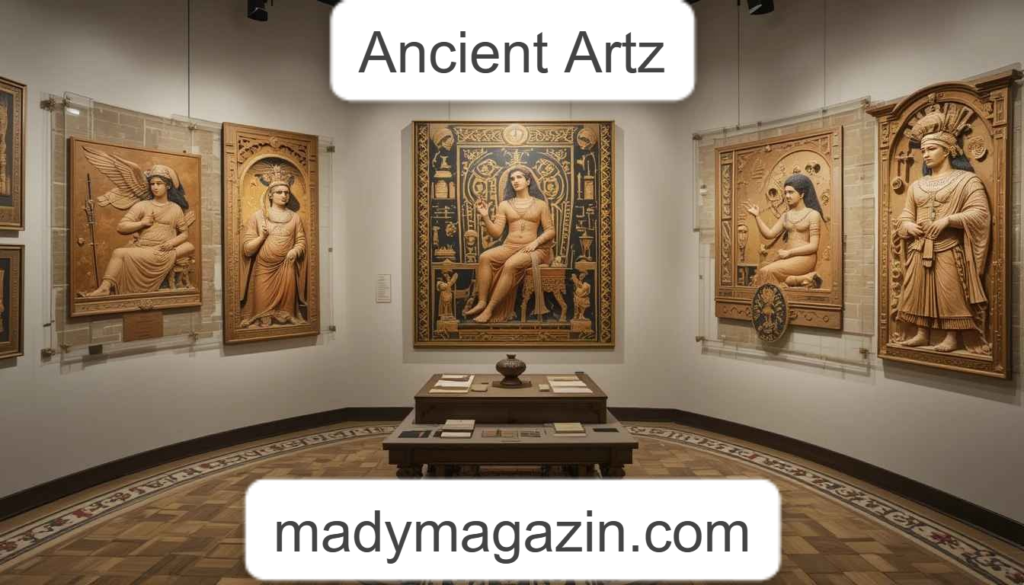
Art continues to be a cornerstone of human expression, offering a profound connection between the past and present. When we speak of “ancient artz,” we delve into a world of timeless masterpieces that hold historical, cultural, and spiritual significance. Today, with growing interest in cultural heritage and digital preservation, ancient art is more accessible and studied than ever before. From the cave paintings of Lascaux to the grand sculptures of Mesopotamia, ancient art tells us how early civilizations viewed religion, power, nature, and human life itself. With modern technology aiding archaeological discoveries and virtual museum tours expanding global access, ancient artworks are no longer just relics of the past—they are active storytellers influencing contemporary artists, scholars, and enthusiasts. This article explores the lasting legacy, diverse styles, and modern relevance of ancient art, shedding light on why these age-old creations continue to captivate and educate us in the digital age.
The Significance of Ancient Artz
Ancient artz is a term that encompasses a wide range of artistic expressions, including sculptures, paintings, pottery, and jewelry, produced by ancient civilizations around the world. This art served multiple purposes, such as religious worship, documentation of historical events, and personal expression. Unlike modern art, ancient artworks were often highly symbolic and closely tied to the cultural and religious practices of their creators.
The primary significance of ancient art lies in its ability to provide us with a direct connection to the past. Through these pieces, we can gain a deeper understanding of how ancient people viewed their world, their gods, and themselves. Art was not just for decorative purposes; it had spiritual and practical importance in the daily lives of people. For example, ancient Egyptian tomb paintings were designed to ensure a safe passage to the afterlife, while Greek sculptures celebrated the beauty of the human form and revered their gods.
Moreover, ancient artz often conveyed the beliefs, values, and social structures of different civilizations. Whether it was the intricate designs of Mesopotamian pottery, the monumental stone carvings of the Mayans, or the vivid frescoes of ancient Rome, these artworks serve as historical documents, allowing us to reconstruct ancient societies and their cultural milestones.
The Evolution of Ancient Artz Styles
Ancient artz evolved through various distinct styles, each influenced by the geographical location, technological advancements, and societal norms of the time. Let’s delve into some of the most iconic artistic movements in ancient history:
Egyptian Art
One of the earliest and most recognizable forms of ancient art comes from Egypt. Egyptian art is known for its symbolic and rigid style, where the human figure was often depicted in a composite view, showing both the front and profile of the body. Art in ancient Egypt was heavily influenced by the belief in an afterlife and the desire to preserve the soul’s journey after death. Monumental sculptures, detailed tomb paintings, and delicate jewelry were created to ensure immortality for both the deceased and the gods.
Greek and Roman Art
In contrast to the Egyptians, the ancient Greeks and Romans focused on humanism and idealized beauty. Greek art is renowned for its pursuit of naturalism, with sculptors such as Phidias and Praxiteles crafting lifelike representations of the human body. Roman art, while influenced by Greek traditions, was more practical, focusing on portraiture and the documentation of historical events. Roman frescoes, mosaics, and statues depicted both gods and everyday life, offering insights into the empire’s daily affairs.
Mesopotamian Art
Mesopotamian art, one of the earliest forms of human artistic expression, is known for its intricate carvings and sculptures. The Sumerians, Akkadians, and Babylonians used art to honor their gods and rulers, as seen in the famous Ziggurat reliefs and the Stele of Hammurabi. These artworks were often ceremonial in nature, telling stories of divine favor and royal power.
Comparison Box: Ancient Art Across Civilizations – Styles, Techniques & Legacy
| Civilization | Time Period | Key Art Forms | Materials Used | Themes & Motifs | Cultural Influence |
|---|---|---|---|---|---|
| Ancient Egypt | 3100–30 BCE | Sculpture, relief carvings, wall paintings, funerary art | Stone, gold, faience, papyrus, pigment | Afterlife, gods, pharaohs, daily life | Strong influence on architecture (pyramids), religious iconography, and symbolic representation in modern art |
| Mesopotamia (Sumer, Akkad, Babylon, Assyria) | 3500–539 BCE | Cylinder seals, bas-reliefs, ziggurat sculptures | Clay, alabaster, bronze | Deities, kingship, warfare, cosmology | Birthplace of cuneiform and narrative art; foundations of visual storytelling |
| Ancient Greece | 1100–31 BCE | Pottery, sculpture, frescoes, architecture (Doric, Ionic, Corinthian orders) | Marble, bronze, terracotta | Humanism, mythology, athletics, beauty | Established realism in sculpture; pillars of Western aesthetics and philosophy |
| Ancient Rome | 753 BCE – 476 CE | Mosaic, fresco, sculpture, portraiture | Marble, concrete, glass, stone | Power, imperial conquest, realism | Legacy in urban design, public art, and civic architecture worldwide |
| Ancient India (Indus Valley, Maurya, Gupta) | 2600 BCE – 600 CE | Terracotta figurines, rock-cut temples, sculptures, Buddhist stupas | Sandstone, granite, ivory, bronze | Nature, deities, spiritual symbolism, mythology | Spiritual depth influenced Buddhism, Hinduism, and Asian art traditions |
| Ancient China (Shang to Han Dynasty) | 1600 BCE – 220 CE | Bronze casting, calligraphy, pottery, silk painting | Jade, bronze, lacquer, silk | Nature, ancestors, harmony, Taoism | Pioneered brushwork, aesthetic balance, and philosophical art traditions |
| Pre-Columbian Americas (Maya, Aztec, Inca) | 2000 BCE – 1500 CE | Stone carving, murals, featherwork, pottery | Obsidian, jade, gold, textiles | Cosmic order, gods, rituals, animals | Rich iconography and craftsmanship reflected in Latin American folk art |
| Ancient African Kingdoms (Nok, Kush, Axum) | 1500 BCE – 600 CE | Terracotta figures, metallurgy, carved ivory, murals | Clay, iron, gold, stone | Ancestry, royalty, spirituality | Inspired Afrocentric aesthetics and early metallurgy in |
Ancient Chinese art, with its long and varied history, is known for its emphasis on balance, harmony, and respect for nature. Early Chinese art primarily involved bronze casting and jade carving, which were used for religious and ceremonial purposes. Later, during the Tang and Song Dynasties, Chinese painters began to focus on landscape art, creating ink wash paintings that celebrated nature’s beauty and philosophical ideas of balance and serenity.
Pre-Columbian Art
In the Americas, ancient civilizations like the Mayans, Aztecs, and Incas produced striking art that was both functional and symbolic. The Mayans, for example, created elaborate stone carvings that told the stories of kings and gods, while the Incas are known for their stunning pottery and textiles, often depicting animals and geometric patterns. These works were deeply connected to their beliefs and often had a ritualistic function.
Ancient Artz in Modern Times
While ancient artz may seem distant, its influence can still be seen in modern art and design. Today, artists and scholars alike look to the masterpieces of ancient civlizations for inspiration. The use of symbolism, the exploration of human form, and the reverence for nature seen in ancient art continue to influence contemporary works.
- Moreover, many ancient art techniques have been rediscovered and revitalized. For instance, the techniques used in ancient Greek sculpture have influenced
- Western art for centuries, while the intricate designs of Islamic art have found their way into modern architecture and interior design.
- Ancient art, in this sense, is not just a relic of the past but an ongoing source of creativity and innovation.
Conclusion
In conclusion, ancient artz offers a rich tapestry of cultural, religious, and historical narratives that have shaped human civilization. From the awe-inspiring monuments of Egypt to the detailed frescoes of Rome, ancient art continues to inspire and educate. By studying these ancient artworks, we not only gain insight into the past but also uncover timeless principles of beauty, symbolism, and human connection. As we look to the future, ancient art will undoubtedly continue to play a vital role in shaping both our understanding of history and our vision of artistic expression.
FAQs
1. What is the main purpose of ancient artz?
The main purpose of ancient artz was to serve religious, cultural, and practical functions. It was used to honor gods, commemorate important events, and convey societal values, while also offering insight into the daily life and beliefs of ancient civilizations.
2. How has ancient art influenced modern art?
Ancient art has influenced modern art in several ways, including its use of symbolism, exploration of human form, and the emphasis on nature. Techniques from ancient art, such as sculpture and painting styles, have been revived and continue to inspire contemporary artists.
3. What are some famous examples of ancient art?
Famous examples of ancient art include the Egyptian pyramids and tomb paintings, the Greek Parthenon sculptures, Roman frescoes, and the intricate Mayan carvings. These works have left a lasting legacy on art and culture across the world.




